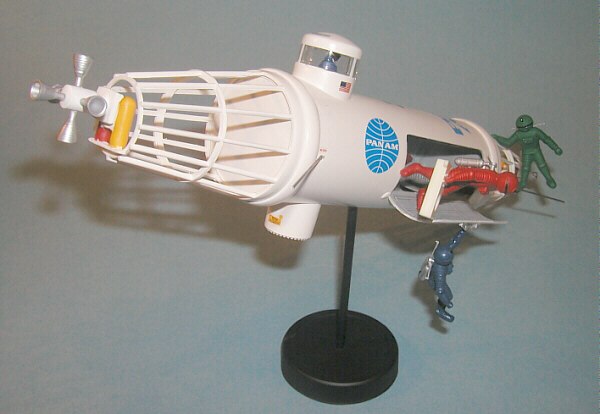
Monogram Space Taxi
|
KIT # |
0194 |
|
PRICE: |
$15.00 |
|
DECALS: |
One vehicle |
|
REVIEWER: |
|
|
NOTES: |
Aftermarket decals |

|
BACKGROUND |
For a look at the kit parts and historical background on Willy Ley's design of the Space Taxi, go to Scott's most excellent preview here.
|
CONSTRUCTION |
Since Monogram's Space Taxi is a hypothetical vehicle -- essentially, a model of a model -- I had no qualms about making two major "improvements" to the good Herr Ley's design based on our four decades of human space flight experience.
As Scott points out in his preview, the only rocket engines included in the kit are a pair of small fore-and-aft thrusters. I wanted my version of the Space Taxi to be equipped for making roll, pitch and yaw maneuvers in space, so I decided to kitbash two new thruster units and relocate them to the ends of the cage-like structures on the Taxi's fuselage.
 The pilot of the Taxi supposedly is in a pressurized compartment, but
you have to wonder how he got in there! The only hatch to the cockpit is
on the outside of the front bulkhead, which would apparently require the
pilot to float though vacuum and (assuming he or she was still alive)
clamber over the maneuvering thruster tanks. There are molded-on
structures at either end of the taxi's fuselage identified in the
painting instructions as "airlock rings," but the corresponding space for
the forward airlock doesn't really look wide enough to hold an adult
human. I wanted to add a more appropriate airlock to make sure my
intrepid pilot would survive to fly another day....
The pilot of the Taxi supposedly is in a pressurized compartment, but
you have to wonder how he got in there! The only hatch to the cockpit is
on the outside of the front bulkhead, which would apparently require the
pilot to float though vacuum and (assuming he or she was still alive)
clamber over the maneuvering thruster tanks. There are molded-on
structures at either end of the taxi's fuselage identified in the
painting instructions as "airlock rings," but the corresponding space for
the forward airlock doesn't really look wide enough to hold an adult
human. I wanted to add a more appropriate airlock to make sure my
intrepid pilot would survive to fly another day....
Before beginning construction, I faced a major decision: what to do with the raised panel lines and rivets that crisscross the fuselage. I would have loved to have kept the 1950s look that the rivets lend to the design, but when test-fitting the fuselage halves together, it was readily apparent that the joints would need serious filling and sanding. Properly restoring the rivets would have been beyond my skills and level of patience, so I chose to sand the surface detail from the fuselage and exterior bulkheads.
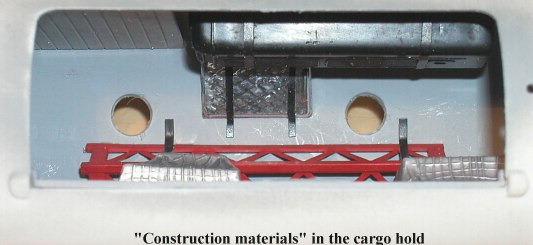 Once the raised detail had been ruthlessly expunged, the next step was
to airbrush neutral gray over the interior of the pilot's compartment,
cargo bay, cargo floor, cargo door interior and inside bulkheads. The
cargo floor features a couple of boxes covered by "netting" molded into
the structure. I hand-brushed the covers metallic silver, then gave them
and the rest of the cargo floor and door a dark gray acrylic "sludge
wash" to bring out details. When everything was dry, I secured the cargo
area bulkhead to the floor and glued the assembly to one fuselage side.
Once the raised detail had been ruthlessly expunged, the next step was
to airbrush neutral gray over the interior of the pilot's compartment,
cargo bay, cargo floor, cargo door interior and inside bulkheads. The
cargo floor features a couple of boxes covered by "netting" molded into
the structure. I hand-brushed the covers metallic silver, then gave them
and the rest of the cargo floor and door a dark gray acrylic "sludge
wash" to bring out details. When everything was dry, I secured the cargo
area bulkhead to the floor and glued the assembly to one fuselage side.
My concern about the fuselage seams proved well-founded when I glued the halves together: The warping left noticeable steps on both top and bottom. It took several applications of gap-filling CA glue and substantial sanding to get a smooth surface without any cracks or pinholes. The worst areas were those where the filler built up on either side of the airlock rings. I used sandpaper wrapped around an old aircraft fin to eliminate the buildup while leaving the profile of the rings reasonably intact.
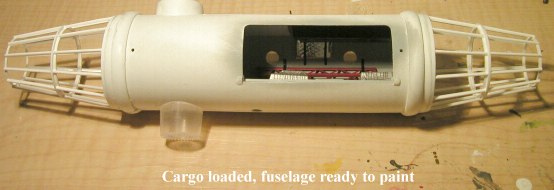 With sanding complete, I turned my attention back to the cargo area.
The compartment looked pretty Spartan with just the molded-in details, so
I raided my spares box for pieces that looked something like orbital
construction materials and superglued them on the cargo floor and walls.
(This also helped hide the very obvious seam inside the upper fuselage.)
I used thin strips of black electrical tape to represent straps holding
the equipment down.
With sanding complete, I turned my attention back to the cargo area.
The compartment looked pretty Spartan with just the molded-in details, so
I raided my spares box for pieces that looked something like orbital
construction materials and superglued them on the cargo floor and walls.
(This also helped hide the very obvious seam inside the upper fuselage.)
I used thin strips of black electrical tape to represent straps holding
the equipment down.
I next glued the bulkheads into place at either end of the fuselage, making sure that the slots for the cages were in the correct position. I cemented the front and rear cage halves together and mounted them to the ends of the Taxi, then glued a cylindrical plastic bottle cap from my spares box beneath the pilot's compartment to represent a semi-realistic airlock and hatch. I finished preparations for painting by using white glue to attach the top piece of the pilot's compartment directly to the opening and to seal the now-closed cargo door.
With major construction out of the way, I concentrated on building more appropriate thruster units for the Taxi. First, I cut the rocket nozzles and support braces from the thruster plates. I then replaced the nozzles with 1/4-inch-long white plastic pegs to serve as a base for larger thrusters from an old 1/32 Monogram Apollo command/service module kit. The plastic in the pegs melted when I tried to drill mounting holes with a motor tool, so I ended up attaching the thrusters directly to the pegs with CA glue, one rocket pointing forward and another on each quadrant. I assembled and brush-painted the thruster tanks red and yellow, and glued them and the two thruster units together.
|
PAINTING & MARKINGS |
Given that the Space Taxi was never even proposed as an actual
vehicle, I felt comfortable coming up with markings more creative than
the kit's "U.S. Space Force" decals. To me, the three space-suited
figures intended to be posed around the
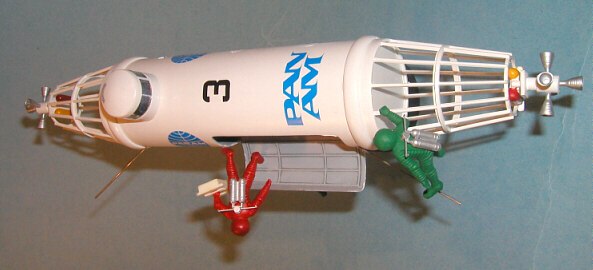 spacecraft bore a passing
resemblance to the astronauts in Stanley Kubrick's masterpiece, 2001:A
Space Odyssey. In the movie, the Orion Earth-to-space station shuttle
is operated by Pan American, and I saw no reason why the air(space)line
couldn't have had a cargo-hauling contract as well! I decided on a
variation of the scheme carried by the Orion vehicle: overall white with
blue Pan Am globes and "PAN AM" titles.
spacecraft bore a passing
resemblance to the astronauts in Stanley Kubrick's masterpiece, 2001:A
Space Odyssey. In the movie, the Orion Earth-to-space station shuttle
is operated by Pan American, and I saw no reason why the air(space)line
couldn't have had a cargo-hauling contract as well! I decided on a
variation of the scheme carried by the Orion vehicle: overall white with
blue Pan Am globes and "PAN AM" titles.
I laid down a flat white coat from a can of generic spray paint. After it had dried for a couple days, I airbrushed several coats of gloss white enamel over the model, using increasing amounts of Floquil thinner, until I was satisfied with the finish.
When the gloss coat was dry to the touch, I applied decals. The blue globes came from a 1/144 Minicraft DC-6B kit and the "PAN AM" lettering from an aftermarket DHC-6 Twin Otter sheet. Atop the pilot's cupola, I placed tiny lettering originally intended for a 1/144 SAS DC-6: "First Over The Pole/Around The World." To me, it fit perfectly with the Space Taxi's mission! My decal spares box yielded black numbers and several data and warning decals. After letting the decals sit overnight, I airbrushed semi-gloss lacquer over the entire model for a more scale appearance and to seal the decals.
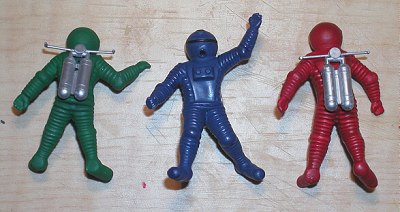 Turning to the crew figures, I used acrylics to give the pilot a dark
blue flight suit, white shirt and African-American complexion. I painted
the three astronauts' spacesuits overall red, green and blue, with gloss
black helmet visors and view ports. Their oxygen/propellant tanks were
painted metallic silver and glued in place on the backs of their suits.
Since these guys would be maneuvering in microgravity around the Taxi
when unloading supplies, I decided to give each a pair of rocket nozzles
for control. I made the nozzles and extension piping from .025 plastic
rod and superglued them to the regulator (?) on the astronauts' tanks.
The pipes and nozzles were painted metallic silver to match the tankage.
Turning to the crew figures, I used acrylics to give the pilot a dark
blue flight suit, white shirt and African-American complexion. I painted
the three astronauts' spacesuits overall red, green and blue, with gloss
black helmet visors and view ports. Their oxygen/propellant tanks were
painted metallic silver and glued in place on the backs of their suits.
Since these guys would be maneuvering in microgravity around the Taxi
when unloading supplies, I decided to give each a pair of rocket nozzles
for control. I made the nozzles and extension piping from .025 plastic
rod and superglued them to the regulator (?) on the astronauts' tanks.
The pipes and nozzles were painted metallic silver to match the tankage.
|
FINAL CONSTRUCTION |
I mounted the completed thruster units directly to the end of the cages using CA glue. I made sure that the forward- and aft-pointing rocket nozzles were at a 90-degree angle compared to the Taxi's body. I also added a pair of wire antennas to the small holes at either end of the fuselage; the kit would have you use these wires as air hoses connected to the astronaut figures, but they looked like perfect antenna material to me.
 Next, I popped off the top of the pilot's cupola and superglued the
painted figure atop the pedestal in the cockpit, facing aft. I then used
white glue to secure the clear window piece and the top to the cupola.
Since I had lost one of the three clear fuselage windows, I filled the
two portholes in the cargo area with scrap plastic and painted over them
to achieve the blanked-off effect sometimes seen on airliners converted
from passenger to cargo service. I used a kit window for the pilot's
compartment after cutting off the locating tabs so I could install it
from the outside.
Next, I popped off the top of the pilot's cupola and superglued the
painted figure atop the pedestal in the cockpit, facing aft. I then used
white glue to secure the clear window piece and the top to the cupola.
Since I had lost one of the three clear fuselage windows, I filled the
two portholes in the cargo area with scrap plastic and painted over them
to achieve the blanked-off effect sometimes seen on airliners converted
from passenger to cargo service. I used a kit window for the pilot's
compartment after cutting off the locating tabs so I could install it
from the outside.
The final assembly step was attaching the three astronauts in "floating" poses around the cargo hold. I used CA glue to secure them directly to different parts of the Taxi, but in retrospect, it probably would have been more efficient to drill tiny holes in the figures and the taxi and join the two using small pieces of wire.
The kit's Earth Globe stand looked too toy-like to me, and it would have put the model at a lower height than I wanted to display it. I scratchbuilt a stand out of brass tubing and the plastic top from a container of Bisquick instant pancake mix. (These circular tops also make excellent bases for 1/144 launch vehicles.) I glued a large metal washer inside to give the stand more stability. After painting the assembly flat black, I superglued it into the hole on the bottom of the Taxi's fuselage.
|
CONCLUSIONS |
The engineering of the Space Taxi is typical for its era, so it's not the easiest build, even with so few parts. But frankly, I had more "fun" constructing this kit than any in recent memory. Perhaps it was because I wasn't trying to meticulously duplicate a prototype, so my imagination had free rein. Modeling? Fun? What a concept!
The Taxi is a dinosaur from the days when space was the place and mass-market model companies thought having art imitate life made good business sense. It's too bad Revell-Monogram's SSP space subjects weren't more popular, but that company (and Glencoe) have done space modelers a great service by resurrecting the few kits they did.
|
REFERENCES |
None consulted. I'm told that Creating Space by well-known space modeler Mat Irvine has some information on the Space Taxi.
July 2003
If you would like your product reviewed fairly and fairly quickly, please contact the editor or see other details in the Note to Contributors.